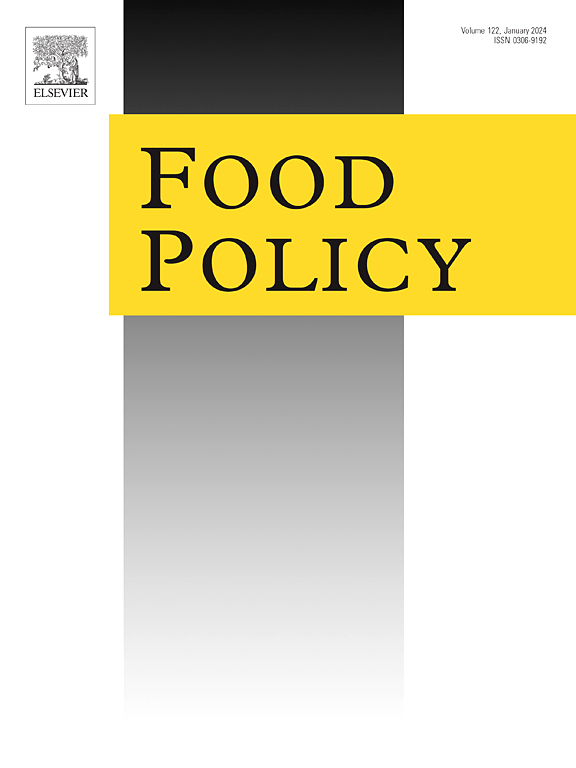What’s the Buzz? Preferences and perceptions of policies to reduce childhood energy drink consumption
IF 6.8
1区 经济学
Q1 AGRICULTURAL ECONOMICS & POLICY
引用次数: 0
Abstract
As global energy drink sales and caffeine content have surged, so have public health concerns over childhood energy drink consumption. With limited regulatory oversight, potential adverse effects, and recent claims of targeted marketing toward children, there is a need to better understand society’s evolving relationship with energy drink markets. This study uses experimental and survey data from a national panel of 1,036 U.S. adults to assess consumer preferences and perceptions toward energy drink policies and marketing. First, we use a best-worst scaling experiment to assess preferences for energy drink labeling requirements, sales channel bans, marketing restrictions, and caffeine caps relative to the status quo. A randomized information treatment also considers how information from health agencies highlighting risks to childhood health affects policy preferences. Without this information, respondents have the strongest preference for a mandatory and prominently displayed caffeine content label. Providing information on the potential childhood health risks, however, increases the relative ranking of policies banning sales to children in retail outlets and high schools. The exploratory survey analysis then provides insights into marketing perceptions that open avenues for future research. For example, we show that it takes the average consumer more than twice as long to find the caffeine content of an energy drink than its calorie count, most consumers believe energy drink packaging is at least somewhat appealing to children, and the perceived target audience of social media marketing varies across brands. These results and the corresponding discussion provide important global policy-relevant insights as the energy drink market develops.
巴斯是什么?减少儿童能量饮料消费的偏好和政策观念
随着全球能量饮料销量和咖啡因含量的飙升,公众对儿童能量饮料消费的健康担忧也在增加。由于监管有限,潜在的不利影响,以及最近针对儿童的目标营销,有必要更好地了解社会与能量饮料市场之间不断变化的关系。这项研究使用了一个由1036名美国成年人组成的全国性小组的实验和调查数据,以评估消费者对能量饮料政策和营销的偏好和看法。首先,我们使用最佳-最差比例实验来评估相对于现状的能量饮料标签要求、销售渠道禁令、营销限制和咖啡因上限的偏好。随机信息处理还考虑了卫生机构强调儿童健康风险的信息如何影响政策偏好。在没有这些信息的情况下,受访者强烈倾向于强制性和显著显示咖啡因含量的标签。然而,提供关于潜在儿童健康风险的信息,提高了禁止在零售店和高中向儿童销售的政策的相对排名。然后,探索性调查分析提供了对营销观念的见解,为未来的研究开辟了道路。例如,我们发现,普通消费者找到能量饮料中咖啡因含量的时间是卡路里含量的两倍多,大多数消费者认为能量饮料的包装至少对儿童有一定的吸引力,而不同品牌的社交媒体营销的目标受众也各不相同。随着能量饮料市场的发展,这些结果和相应的讨论提供了重要的全球政策相关见解。
本文章由计算机程序翻译,如有差异,请以英文原文为准。
求助全文
约1分钟内获得全文
求助全文
来源期刊

Food Policy
管理科学-农业经济与政策
CiteScore
11.40
自引率
4.60%
发文量
128
审稿时长
62 days
期刊介绍:
Food Policy is a multidisciplinary journal publishing original research and novel evidence on issues in the formulation, implementation, and evaluation of policies for the food sector in developing, transition, and advanced economies.
Our main focus is on the economic and social aspect of food policy, and we prioritize empirical studies informing international food policy debates. Provided that articles make a clear and explicit contribution to food policy debates of international interest, we consider papers from any of the social sciences. Papers from other disciplines (e.g., law) will be considered only if they provide a key policy contribution, and are written in a style which is accessible to a social science readership.
 求助内容:
求助内容: 应助结果提醒方式:
应助结果提醒方式:


